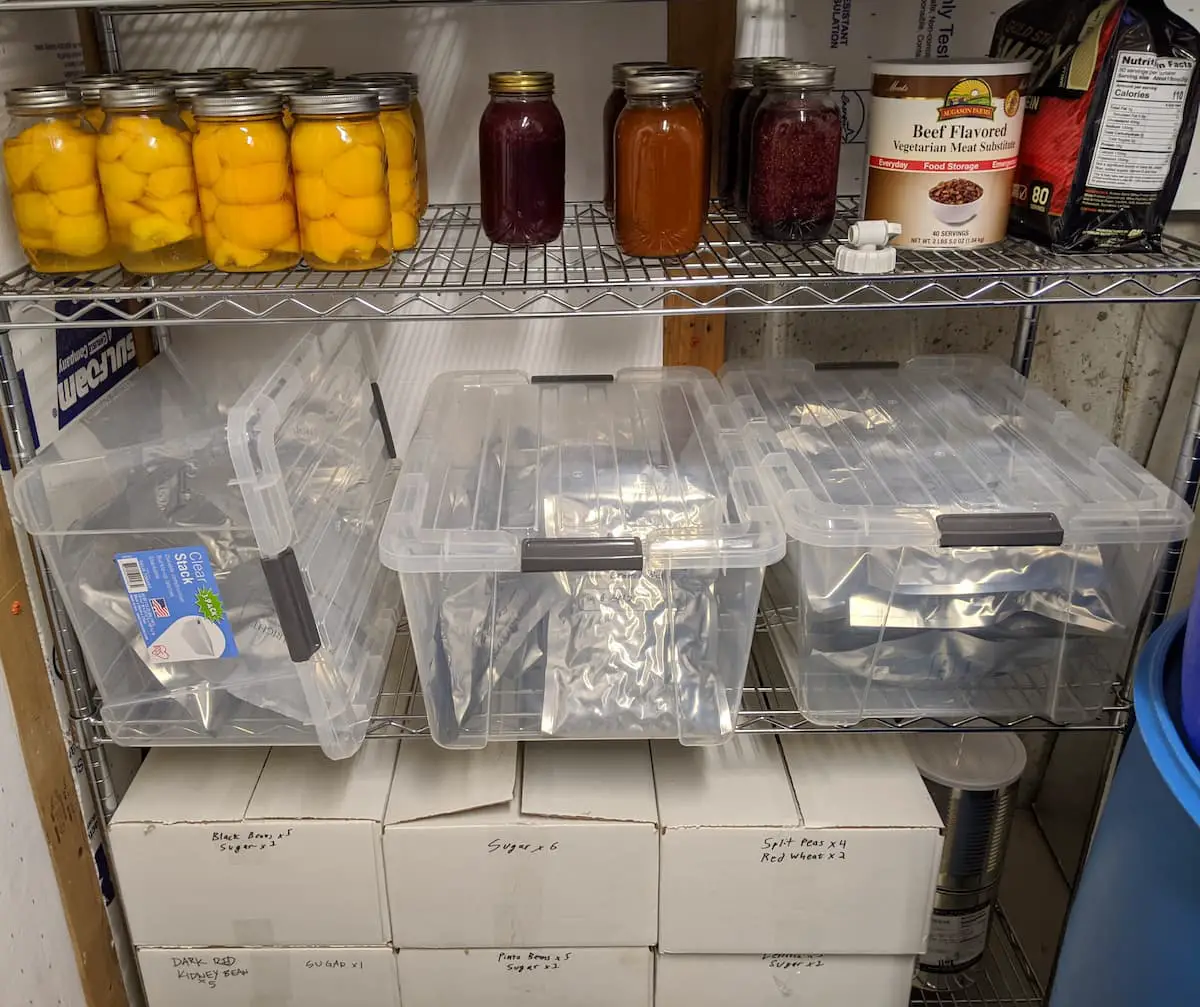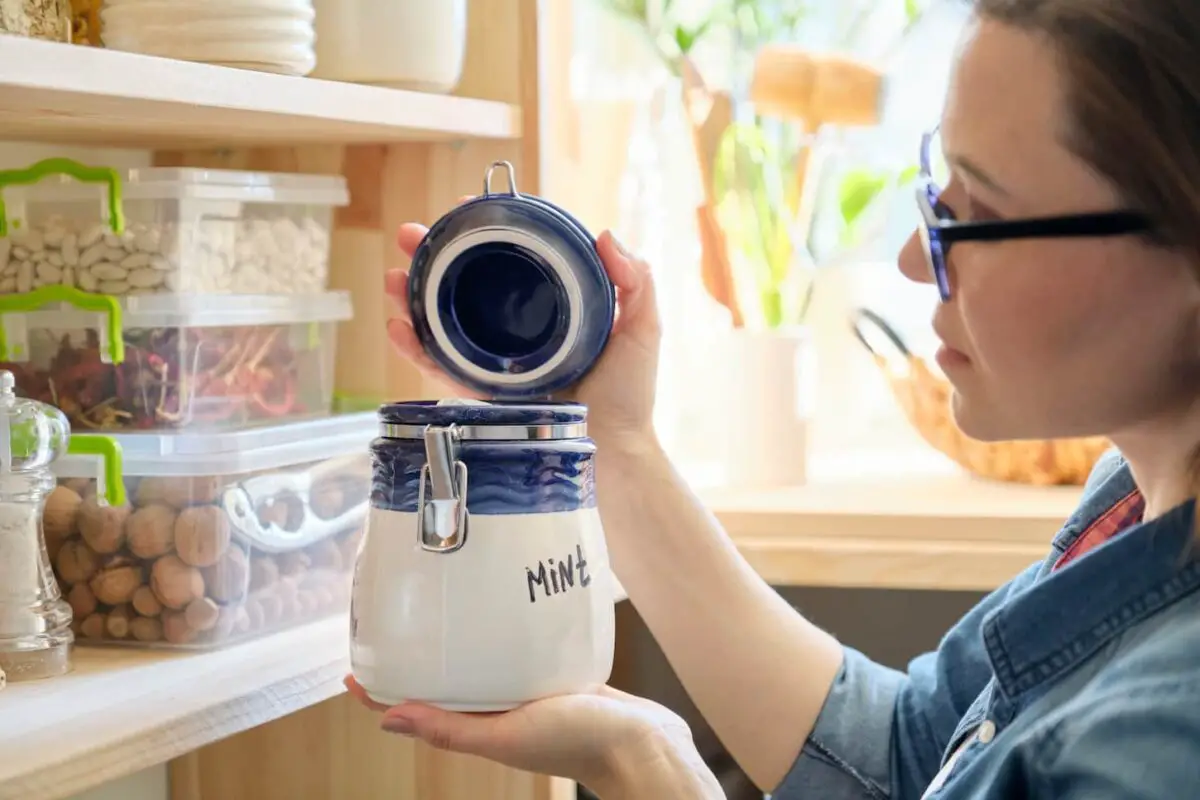Freeze-drying food is a great first step towards long-term storage and causes less food waste. However, we still have to store that food; if we don’t do that correctly, it will spoil, which is why many ask how to store food properly.
Storing freeze-dried food in a cool, dark pantry is the safest way to store these shelf-stable foods. Store any foods (including freeze-dried ones) in safe containers in a location that can keep the temperature and humidity low and control light levels.
If you’re considering storing freeze-dried food, it’s important to know how to do it properly to ensure it stays fresh and edible for as long as possible. There are several factors to consider when storing freeze-dried food, including temperature, humidity, and container type. By storing your freeze-dried food properly, you can ensure that you have a supply of nutritious and delicious food on hand whenever you need it.

How to Store Freeze-Dried Food
Proper storage of freeze-dried foods is essential to maintain their quality and longevity. Here are some tips on how to store freeze-dried foods:
Choose the Right Container
When it comes to storing freeze-dried foods, the right container is critical. You want to choose an airtight container to keep moisture and oxygen out.
Mylar bags are a popular option for long-term storage because they are durable, lightweight, and easy to seal. You can also use sealable Mason jars (get a vacuum-sealer for even longer storage) or containers with oxidizers added to keep your food fresh longer.
Prepare the Food for Storage
Before storing your freeze-dried food, you need to prepare it properly. Make sure the food is completely dry before packing it in an airtight container. Moisture can cause the food to spoil quickly, so removing as much moisture as possible is essential. You can use a food dehydrator or oven to dry the food before packing it.
It’s also a good idea to add an oxygen absorber to your container to remove any oxygen that may be present. Oxygen can cause the food to degrade over time, so removing it will help keep your food fresh for longer.
Store in a Cool and Dry Place
Once you’ve packed your freeze-dried food in an airtight container, it’s time to store it in a cool and dry place. Temperature and humidity are critical factors in the shelf life of your food. You should store your food where the temperature stays below 60°F and the relative humidity is less than 80%. Avoid storing your food in direct sunlight or any other type of light, as this can cause the food to degrade more quickly.
Rotating your food regularly is also important to ensure you use the oldest food first. This will help prevent waste and ensure you always have fresh, high-quality food.
Best Place for Freeze-Dried Food: the Pantry
While the freezer is usually the best place to keep food, freeze-dried foods are shelf-stable and can be kept in a dark, cool pantry for the best (and longest) storage results.
The biggest notable difference between a freezer and a pantry is the temperature.
The temperature isn’t that important, though. What’s most important is that a) the container itself is completely sealed off and doesn’t let moisture get through to the food, and b) the temperature isn’t higher than 60°F (ideally, it’s between 37°and 40°F).
- If the food container is opened, it won’t matter how low or dark the temperature is – the food will absorb moisture and spoil.
- If the container is sealed properly and safely, it shouldn’t deteriorate quickly.
If your pantry doesn’t have room for your freeze-dried foods, find a similar indoor location – like in a closet, under a bed, or in a storage room.
Avoid storing freeze-dried foods under sinks or in bathrooms.

This is a peek at our food storage. It’s in a basement-level cold storage pantry.
Tips for Storing Freeze-Dried Foods
Storing freeze-dried foods properly is critical to ensuring their longevity and quality. Here are some tips to help you store your freeze-dried foods:
Labeling and Organizing
When storing freeze-dried foods, it’s important to label and organize them properly. You can use labels or markers to identify the contents of each container or bag.
Organize your food by types (such as fruits, vegetables, meats, and grains) to make it easier to find what you need. You can also use clear plastic bins or shelves to keep your food organized and easily accessible.
Rotating Your Stock
Rotating your freeze-dried food stock is essential to ensure that you are using the oldest items first. This helps prevent waste and ensures that you always have fresh food.
Consider using a first-in, first-out (FIFO) system to keep track of your stock. This means using the oldest items first and adding new items to the back of your storage area.
Avoiding Moisture and Contamination
Moisture and contamination can cause your freeze-dried food to spoil, so it’s important to take steps to prevent them. Store your food in a cool, dry place, away from direct sunlight and moisture.
You can use oxygen absorbers or vacuum-sealed containers to remove oxygen and prevent moisture from getting in. Keep your storage area clean and free from pests to avoid contamination.
By following these tips, you can ensure that your freeze-dried foods stay fresh and last for years.
Ideal Conditions to Store Freeze-Dried Food
The best way to store freeze-dried food is in Mylar bags in a humidity and temperature-controlled area, like a cold storage pantry. The temperature is low, Mylar bags will not let any moisture inside, and the environment keeps the food safe.
Properly freeze-dried food can potentially be stored for more than two decades.
If you must put your Mylar bags in the freezer, read our guide first: Can You Freeze Food in Mylar Bags?
Ideal Temperature
At or below 60°F is the ideal temperature for storing freeze-dried foods for a long time. Keeping freeze-dried foods below 40°F (a standard refrigerator setting) is even better and will make them last longer.
However, some foods can be stored at higher temperatures, and the longevity depends on the type of food as much as the temperature.
For example, dried fruits can last about a year if stored at 60°F but only six months if stored at 80°F. Frozen foods may last indefinitely.
Note: freeze-drying is the newest long-term storage method, which is still unexplored. It has great potential; theoretically, we could store food for multiple decades before it goes bad.
Are you interested in reading more about freeze-dried foods and how to freeze-dry them? Then, read this informative article: How to Freeze Dry and Store Your Favorite Foods: Guide with Pictures.
Ideal Humidity Level
The humidity level in a storage area should be less than 50%, preferably below 35%. However, the moisture level is less important if we freeze-dry the food properly and seal it in airtight containers.
Since freeze-drying removes all (or almost all) moisture from the food, it must be sealed in an airtight container so no air can get in.
The official recommendation by Harvest Right, one of the foremost manufacturers of freeze-dryers, is to keep the food in Mylar bags or #10 cans that are sealed with a can sealer. Mason jars are an option, too.
If we plan on eating something soon, we don’t have to keep it in mylar bags or sealed jars – regular jars will do.
Ideal Light Level
Ideally, a storage room is completely dark. This is why freezers are the best option for storing freeze-dried foods; not only are they cold, but they are also pitch-black inside.
While light affects the rate of deterioration, it’s not as nearly as important as temperature and humidity.
Photodegradation (food spoiling because of light) is slow, usually resulting in the loss of vitamins and discoloration because chlorophyll is destroyed.
Less-Great Places to Store Freeze-Dried Food
Freeze-dried foods are commonly stored where there is room: in pantries, closets, storage rooms, or anywhere else. Freeze-dried foods should not be stored anywhere prone to extreme temperatures or where animals could get into the food.
If you don’t have an indoor location for storing your freeze-dried foods, they can be stored in another location. However, the foods will not last as long as they could in a temperature-controlled environment. We’ll get into that.
Garage
People can safely store freeze-dried food in a garage if it is dry, cool, and temperature controlled. If the garage is not temperature controlled, it is a less-than-ideal solution. The seasonal temperature fluctuations will speed up the spoiling process.
Regarding garages, animals are also a concern. Animals are probably more dangerous to the food in a garage than temperature fluctuations and moisture.
Mice, rats, squirrels, skunks, raccoons, and possums are just some of the few animals known for invading our homes (and garages!) looking for food. If they find any freeze-dried food, they’ll tear the bags open and eat them.
This is why we should store freeze-dried foods in a container with safety locks and keep them in Mylar bags.
Regarding spoilage, the garage isn’t a good storing option during the summer because the high temperatures will speed up the decomposition process.
Outside sheds
It is possible, but do not store freeze-dried food outside unless necessary, as it won’t last as long. We cannot control humidity levels, temperature, or light outside. There is also the added problem of keeping animals away from food.
Be it storing the food in a shed or a large container; it is still susceptible to outside temperatures and humidity because the thin walls of such structures can’t compare to the isolation a house provides.
Animals can still get in sheds – at least they get in mine!
If you must store your food outside, I recommend double-packing it. Put Mylar bags into plastic containers less likely to be gnawed into by animals. Mason jars won’t likely be gnawed, but I’d still double-pack them to prevent them from getting knocked over and broken.
It’s imperative that food is kept in a safe container so that animals can’t break through!
Shelf-Life of Freeze-Dried Foods Stored in Garages or Sheds
Freeze-dried foods stored in less-than-ideal circumstances could last days, weeks, months, or years, depending on the circumstances. Improperly sealed packages will shorten the life span of the food more than other factors (light, heat, humidity).
In theory, freeze-dried food stored correctly can last for 25 years. However, the food will not last long if the storage area is warm, has too much light, or is too humid – especially if the food isn’t properly sealed.
The exact number is hard to determine because it depends on several factors. The most important one is the type of food – freeze-dried meats, fruits, and vegetables all have different expiration dates in ideal circumstances.
Secondly, we have moisture levels – if the container lets moisture in and the humidity level in the storage room is low (less than 30%), the food will start to spoil, but it won’t spoil quickly.
If the humidity level exceeds 50%, freeze-dried food will spoil quickly.
If the temperature in the pantry is too high, or there is too much light coming in, or the food container is opened – the food will spoil in a matter of days.
If none of that happens, the food will stay edible for years, possibly decades.
Considering all of this, we hope you understand why it’s difficult to say anything more than the food won’t last long – whether it’s a question of days or years is difficult to discern.

Frequently Asked Questions
Frequently Asked Questions
We’re here to help! Check out our FAQs section below for answers to common questions. If we missed yours, let us know, and we’ll update the article. Contact us through our website, and we’ll respond directly to your question.
Does Freeze-Dried Food Need to Be Refrigerated?
Freeze-dried foods do not need to be refrigerated or frozen. Keeping them in a pantry is safe if it is cool, dark, and dry. However, a refrigerator will keep the food at a lower temperature than a pantry, so it is an option.
Once stored in a fridge, though, freeze-dried foods should stay there. If they get moved to a pantry shelf, the food container will experience water condensation, which can affect the food (depending on the container’s porosity and other factors).
Does Freeze-Dried Food Need to Be Stored at Room Temperature?
Freeze-dried food does best when stored at about 60°F, but preferably around 40°F. Storing it at room temperature will not ruin it instantly, but it is too warm to be stored safely for a long time.
When storing freeze-dried foods in the pantry, the temperature should be between 50 and 70°F, according to research. Room temperature is just above that, so it’ll cause slow food deterioration.
Keep one thing in mind when storing food in a pantry – even if the thermometer is showing the right temperature, storing food near heating pipes or next to a device that lets off heat will spoil your food.

Verdict: Storing Freeze-Dried Foods
Freeze-drying is an excellent way to preserve food for long periods without sacrificing taste or nutrition.
With a lower moisture content, freeze-dried foods offer a shelf life of 25 years compared to 4 months to 1 year for dehydrated foods. Freeze-dried foods rehydrate faster and tend to retain their original shape, texture, and color (some leafy greens don’t do so great).
When storing your freeze-dried foods, keeping them in sealed containers such as mylar bags, sealable cans, or containers with added oxygen absorbers is important. The storage area should be free from direct sunlight, dry, temperature-controlled, and free of infestation from pests and rodents.
Lastly, it is important to note that while freeze-dried foods are an excellent option for long-term storage, they should not be relied upon as the sole source of nutrition. Maintaining a varied and balanced diet is important to ensure you get all the nutrients your body needs.
Food storage isn’t that dramatic. As long as storage containers keep moisture and oxygen out and we keep them in a cool, dry, and dark spot – the food will stay edible for years to come.
Even if we fail at one of those aspects, the food won’t spoil quickly, and we’ll have time to eat it.
Want to ensure your whole food storage is safe to eat for years? Read our tips and tricks in Where to Keep Food Storage: Complete Guide.
Resources
Learning from your own experience is essential, but learning from others is also intelligent. These are the sources used in this article and our research to be more informed as homesteaders.
- Drying. National Center for Home Food Preservation | How Do I? Dry. (n.d.). Retrieved February 21, 2023, from https://nchfp.uga.edu/how/dry/pack_store.html
- Food storage for safety and quality – UGA. (n.d.). Retrieved February 21, 2023, from https://nchfp.uga.edu/how/store/UGA_foodstorage_2011.pdf
- Right, H. (2019, November 14). How to store freeze Dried Food: Harvest Right™: Home freeze dryers: Freeze-dried food storage. Harvest Right™ | Home Freeze Dryers | Freeze Dried Food Storage. Retrieved February 21, 2023, from https://harvestright.com/blog/2017/how-to-store-freeze-dried-food/
- Shelf-Stable Food Safety | Food Safety and Inspection Service. (n.d.). https://www.fsis.usda.gov/food-safety/safe-food-handling-and-preparation/food-safety-basics/shelf-stable-food